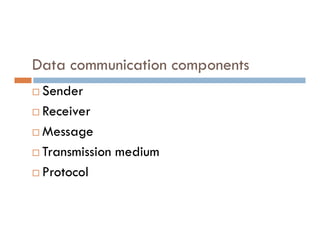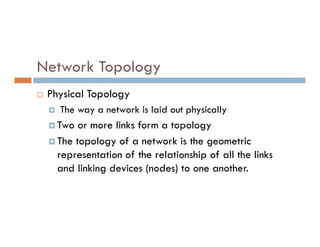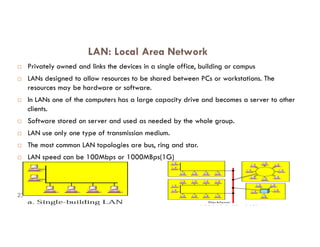Ad
DCCN Unit 1.pdf
- 1. DATA COMMUNICATION AND Course Instructor: Dr. C. Sreedhar AND COMPUTER NETWORKS Some contents are copied from Internet sources Unit - I
- 2. Unit 1 Introduction: Data Communication, Components, Data Representations, Dataflow, Network Topologies, categories of networks, Internet, protocols and standards. Internet, protocols and standards. Network Models: Layered tasks, OSI Reference model, layers in OSI model, TCP/IP Protocol suite, Addressing – Physical address, Logical address, port
- 3. Unit 1 Data Communications Definition Components of DC Data representation Data flow Protocols and Standards Definition Standards Data flow Networks Network criteria Types of connections Categories of topology Network Models Standards
- 4. Data Communication: Definition Data communications are the exchange of data between two data between two devices via some form of transmission medium such as a wire cable.
- 5. Data Communication The effectiveness of a data communications system depends on four fundamental characteristics: Delivery: deliver data to the correct destination Accuracy: system must deliver the data accurately Timeliness: system must deliver data in a timely manner Jitter: refers to the variation in the packet arrival time
- 6. Data Communication: Components Five components 1. Sender 2. Message 3. Transmission 3. Transmission medium 4. Protocol 5. Receiver
- 7. Protocol & its elements Definition: Set of rules that governs data communications. Syntax Structure or format of the data Indicates how to read the bits - field delineation Indicates how to read the bits - field delineation Semantics Interprets the meaning of the bits Knows which fields define what action Timing When data should be sent and what Speed at which data should be sent or speed at which it is being received.
- 8. Data communication components Sender Receiver Message Message Transmission medium Protocol
- 9. Data Representation Text: Text is represented as a bit pattern. Unicode uses 32 bits to represent a symbol or character Numbers Numbers are also represented by bit patterns. Numbers are also represented by bit patterns. number is directly converted to a binary number Images Images are also represented by bit patterns. image is composed of a matrix of pixels each pixel is assigned a bit pattern. Audio and Video:
- 10. Data Flow Communication between two devices can be simplex or half-duplex, or full-duplex
- 11. Networks A network is a set of devices (nodes) connected by communication links. Node: Node: computer, printer, or any other device capable of sending and/or receiving data. Link: can be a cable, air, optical fiber, or any medium which can transport a signal carrying information.
- 12. Network Criteria Performance: Measured: transit time and response time Transit time: time required for a message to travel from AB Transit time: time required for a message to travel from AB Response time: elapsed time between inquiry and response Evaluated using two metrics: throughput and delay (more throughput and less delay). Reliability: measured by the frequency of failure Security: Network security issues include protecting data from unauthorized access
- 13. Network Topology Physical Topology The way a network is laid out physically Two or more links form a topology Two or more links form a topology The topology of a network is the geometric representation of the relationship of all the links and linking devices (nodes) to one another.
- 14. Topology Physical topology Is how the wires are run The way in which a network is laid out physically Logical topology is how the signal travels. A device can be wired to implement any logical topology. A device can be wired to implement any logical topology. LANs are logical busses or rings, depending on how the hub is wired 4 basic types: mesh, star, bus, ring The most common physical topology is the star. All the wires come back to a central point May often hybrid
- 15. Mesh Topology Every link is dedicated point-to-point link The term dedicated means that the link carries traffic only between the two carries traffic only between the two devices it connects To link n devices fully connected mesh has: n ( n - 1) / 2 physical channels (Full-Duplex) Every Device on the network must have n - 1 ports
- 16. Advantages Each connection carry its own data load (no traffic problems) Disadvantages Big amount of cabling Big number of I/O ports Installation and Mesh Topology traffic problems) A mesh topology is robust Privacy or security Fault identification and fault isolation Installation and reconnection are difficult Sheer bulk of the wiring can be greater than the available space Hardware connect to each I/O could be expensive
- 17. A star topology each device needs only one link and one I/O port to connect it to any number of others Advantages less expensive than a mesh topology. robust: If one link fails, only that link is robust: If one link fails, only that link is affected Disadvantages If the hub goes down, the whole system goes down. The star topology is used in local-area networks (LANs)
- 18. bus topology Nodes are connected to the bus cable by drop lines and taps A drop line is a connection running between device and main cable. A tap is a connector A tap is a connector One long cable acts as a backbone to link all the devices in a network Advantages bus uses less cabling than mesh or star topologies Disadvantages difficult reconnection and fault isolation Signal reflection at the taps can cause degradation a fault or break in the bus cable stops all transmission
- 19. Ring topology
- 20. Ring Topology Each device has a dedicated point to point connection with only two devices on either side of it. Signal is passed along the ring in one direction till it reaches destination Each device has a repeater When a device receives signal to be passed, its repeater regenerates bits and passes along. Advantages Easy to install and reconfigure Fault isolation is simple Disadvantages Unidirectional traffic Break in the ring disables entire network; solved by dual ring
- 21. A hybrid topology: a star backbone with three bus networks Main Star topology with each branch connecting several stations in a bus topology
- 22. Networks Categories Network category is determined by its size, ownership, the distance it cover and its physical architecture
- 23. LAN: Local Area Network Privately owned and links the devices in a single office, building or campus LANs designed to allow resources to be shared between PCs or workstations. The resources may be hardware or software. In LANs one of the computers has a large capacity drive and becomes a server to other clients. Software stored on server and used as needed by the whole group. 23 Software stored on server and used as needed by the whole group. LAN use only one type of transmission medium. The most common LAN topologies are bus, ring and star. LAN speed can be 100Mbps or 1000MBps(1G)
- 24. MAN: Metropolitan Area Network Owned by private company or it may be a service provided by public company ( such as local tel.-company) Extended over an entire city. May be single network such as a cable television network, or it may be connected number of LANs into a large network so that resources may be shared LAN-TO-LAN. Examples: 24 Examples: Company can use MAN to connect the LANs in all its offices throughout the city. A part of the telephone line network that can provide DSL line to the customer
- 25. WAN: Wide Area Networks Provides long distance transmission of data, voice , image and video information over large areas ( country or whole world) In contrast to LAN, WAN may utilize public or private communication equipment's or combination 25
- 26. LAN MAN WAN LAN is a wired network, i.e., all the computers and printers are connected through wires. The connections in MAN are connected through modem or cables/ wires. The network of WAN is connected through broadband services, 3G or 4G internet services, etc. The ownership of LAN is private. Ownership of MAN might be public or private. private or public. The internet speed of LAN is very high, i.e., 1000 Mbps. The sped of MAN is moderate, i.e., 44-155 Mbps. The speed of WAN is relatively less than MAN and LAN, i.e., 150 Mbps. 26 The maintenance cost of LAN is easy. The maintenance cost of MAN is difficult. The maintenance cost of WAN is difficult. The bandwidth of LAN is high. The bandwidth of MAN is less. The bandwidth of WAN is relatively low. Examples: College School University Hospital Examples: City Building Examples: Broadband and internet throughout the country or continent.
- 27. Elements of Protocol Elements of a protocol: Syntax Semantics Timing Timing Syntax: structure or format of data
- 28. Elements of protocol Semantics: meaning of each section of bits Timing: when data should be sent and how fast they can be sent
- 29. Standards Two categories De facto: not approved by an organized body but adopted De jure: Legislated by an officially recognized body Standards Creation Committees a) International Standards Organization (ISO): product: quality, safety b) International Telecommunications Union (ITU): comm’ spectrum b) International Telecommunications Union (ITU): comm’ spectrum c) American National Standards Institute (ANSI): standards d) Institute of Electrical and Electronics Engineers (IEEE): promote technology, education, innovation e) Electronic Industries Association (EIA): protection to envronment, health f) Internet Engineering Task Force (IETF): standards for TCP/IP
- 30. OSI Model OSI: Open Systems Interconnection Established in 1947, International Standards Organization (ISO) is a multinational body Organization (ISO) is a multinational body dedicated to worldwide agreement on international standards. An ISO standard that covers all aspects of network communications is the OSI model. It was first introduced in the late 1970s.
- 31. OSI Model: Layers Application Layer Presentation Layer Session Layer Transport Layer Network Layer Data Link Layer Physical Layer
- 32. The interaction between layers in the OSI model
- 33. 7 Application 6 Presentation 5 Session 4 Transport OSI REFERENCE MODEL 1. Physical Layer 1. Movements of individual bits 2. Physical characteristics of interface, medium 3. Representation of bits 4. Data rate 5. Synchronization of bits 4 Transport 1 Physical 2 Data Link 3 Network 5. Synchronization of bits 6. Line configuration 7. Topology 8. Transmission mode
- 34. Physical Layer Responsibilities 1. Movements of individual bits 2. Physical characteristics of interface, medium 3. Representation of bits 3. Representation of bits 4. Data rate 5. Synchronization of bits 6. Line configuration 7. Topology 8. Transmission mode
- 35. Duties of the Physical layer Responsible for movements of individual bits from one hop (node) to the next Physical characteristics of interfaces and media It defines the characteristic of the interface between devices and media. It also define the type of transmission media Representation of bits Representation of bits The bit stream must be encoded into signals. It defines the type of representation ( how 0, 1 are changed to signal). Data rate It defines the number of bits sent per second and also the duration of bits Synchronization of bits The sender and receiver must be use the same bit rate also the receiver clock must be synchronized
- 36. Duties of the Physical layer Line configuration Physical layer is concerned with the connection of devices to the media ( point-to point or multipoint) Physical topology How devices connected to make a network How devices connected to make a network Devices can connected by using Star, mesh , bus, ring or hybrid topology Transmission mode It defines the direction of transmission between two devices (simplex, half-duplex, or full duplex)
- 37. 7 Application 6 Presentation 5 Session 4 Transport OSI REFERENCE MODEL 2. Data Link Layer a) Frames b) Physical addressing (MAC) c) Flow control d) Error control e) Access control •Error detection and correction methods 4 Transport 1 Physical 2 Data Link 3 Network •Error detection and correction methods •IEEE LAN standards • Bridges • Switches
- 38. Data Link Layer: Frame
- 39. Data Link Layer Flow control
- 40. DLL: Flow Control : Stop and Wait
- 41. DLL : Error control
- 44. DLL: Hop to Hop delivery
- 45. Data Link Layer Example
- 46. 7 Application 6 Presentation 5 Session 4 Transport OSI REFERENCE MODEL 3. Network Layer a)Logical Addressing b)Routing packets from source to destination. • Internetworking • Routing algorithms • Internet Protocol (IP) addressing • Routers 4 Transport 1 Physical 2 Data Link 3 Network
- 49. 7 Application 6 Presentation 5 Session 4 Transport OSI REFERENCE MODEL 4.Transport Layer a)Port Address b)Segmentation and Reassembly c)Connection control d)Flow control e)Error control • Provides additional Quality of Service. 4 Transport 1 Physical 2 Data Link 3 Network • Provides additional Quality of Service. •TCP, UDP
- 50. Transport Layer
- 51. Transport Layer: Port Numbers
- 53. Connection Oriented Service Connectionless Service
- 54. 7 Application 6 Presentation 5 Session 4 Transport OSI REFERENCE MODEL 5.Session Layer a)Allows users on different machines to establish sessions between them. b)dialogue control. c) Token management. d) Synchronization. 4 Transport 1 Physical 2 Data Link 3 Network
- 55. 7 Application 6 Presentation 5 Session 4 Transport OSI REFERENCE MODEL 6. Presentation Layer a) Concerned with the syntax and semantics of the information (Translation) b) Data compression. c) Data encryption. 4 Transport 1 Physical 2 Data Link 3 Network c) Data encryption.
- 56. 7 Application 6 Presentation 5 Session 4 Transport OSI REFERENCE MODEL 7. Application Layer a) Provides protocols that are commonly needed. Main topics: • File Transfer Protocol (FTP) • HyperText Transfer Protocol (HTTP) • Simple Mail Transfer Protocol (SMTP) • Simple Network Management Protocol (SNMP) 4 Transport 1 Physical 2 Data Link 3 Network • Simple Network Management Protocol (SNMP) • Network File System (NFS) • Telnet
- 57. OSI Model: Summary Image is copied from Forouzan
- 58. TCP / IP Protocol Suite TCP: Transmission Control Protocol IP : Internet Protocol
- 59. HTTP Image is copied from Forouzan
- 60. ARP Address Resolution Protocol (ARP) is a communication protocol used for discovering MAC address, associated with a given IP address. Map a logical Address to a physical Address An ARP request is broadcast; an ARP reply is unicast.
- 61. RARP Reverse Address Resolution Protocol: Map a Physical Address to a logical Address RARP request packets are broadcast;RARP reply packets are unicast.
- 62. Image is copied from Forouzan
- 63. IP Protocol IP Protocol • •IP provides unreliable and connectionless IP provides unreliable and connectionless datagram delivery. datagram delivery. • •IP protocol has no error IP protocol has no error- -reporting or error reporting or error- - correcting mechanism. correcting mechanism. correcting mechanism. correcting mechanism. • •Logical Address in TCP/IP are called IP Address Logical Address in TCP/IP are called IP Address
- 64. ICMP: Internet Control Message Protocol used by network devices (routers etc.,) to send error messages. IGMP: Internet Group Management Protocol is a communications protocol used by hosts and adjacent routers on IPv4 networks to establish multicast group memberships TCP: Transmission Control Protocol TCP: Transmission Control Protocol provides Connection oriented service such as reliable, ordered, and error-checked delivery of data. UDP: User Datagram Protocol uses a connectionless communication where error checking and correction are not necessary. Used for time-sensitive applications.
- 65. SMTP: Simple mail transfer protocol is an Internet standard for electronic mail (email) transmission HTTP: Hyper Text Transfer Protocol is an application protocol and forms foundation for is an application protocol and forms foundation for data communication using World Wide Web(www) FTP: File Transfer Protocol is a standard network protocol used for transfer of computer files between a client and server on a computer network
- 66. DNS: Domain Name System hierarchical decentralized naming system, responsible for assigning domain names and mapping those names to Internet resources (Phonebook of Internet) SNMP: Simple Network Management Protocol used for collecting and organizing information about managed devices on IP networks. Monitor and manage network devices over an IP. on IP networks. Monitor and manage network devices over an IP. RPC: remote procedure call Computer program can execute a procedure in a different address space. Used to communicate bw processes on different workstations. POP: Post Office Protocol used by e-mail clients to retrieve e-mail from a server in an IP network
- 67. Image is copied from Forouzan
- 68. Example : physical addresses Data 87 10 1 packet discarded 2 packet discarded 3 packet accepted Data 87 10 4 Image is copied from Forouzan
- 69. logical addresses Data A P 20 10 Data A P 20 10 Physical addresses changed Data A P 33 99 69 changed Data A P 33 99 Physical addresses changed Data A P 95 66 Data A P 95 66 Image is copied from Forouzan
- 70. A Sender Receiver P port numbers Data Data Internet a Data j A P H2 a Data j A P a Data j Data a Data j A P H2 a Data j A P a Data j Data Image is copied from Forouzan






























































































































































